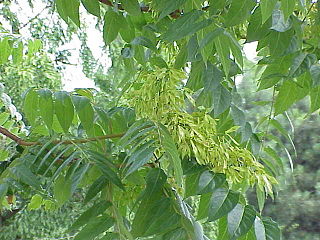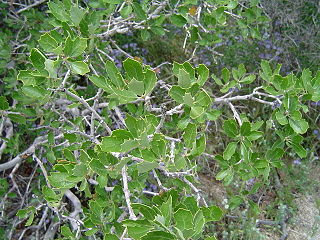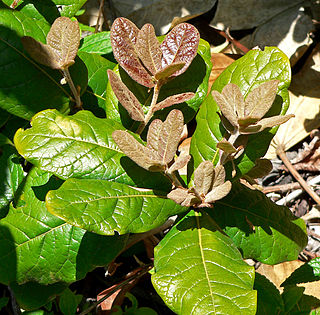
The Simaroubaceae are a small, mostly tropical, family in the order Sapindales. In recent decades, it has been subject to much taxonomic debate, with several small families being split off. A molecular phylogeny of the family was published in 2007, greatly clarifying relationships within the family. Together with chemical characteristics such as the occurrence of petroselinic acid in Picrasma, in contrast to other members of the family such as Ailanthus, this indicates the existence of a subgroup in the family with Picrasma, Holacantha, and Castela.
Discocarpus is a genus of the plant family Phyllanthaceae first described as a genus in 1841. It is native to northern South America. It is dioecious, with male and female flowers on separate plants.
- Discocarpus essequeboensisKlotzsch - Brazil, Venezuela (Amazonas), Guyana, Suriname, French Guiana
- Discocarpus gentryiS.M.Hayden - S Venezuela (Amazonas), Peru (Loreto), N Brazil
- Discocarpus pedicellatusFiaschi & Cordeiro - State of Bahia in Brazil
- Discocarpus spruceanusMüll.Arg. - Venezuela (Amazonas), Brazil, Suriname (Sipaliwini), Bolivia

Quercus berberidifolia, the California scrub oak, is a small evergreen or semi-evergreen shrubby oak in the white oak section of Quercus. It is a native of the scrubby hills of California, and is a common member of chaparral ecosystems.

Resedaceae is a family of mostly herbaceous dicotyledonous plants comprising 107 known species in 8 to 12 genera.

Quercus costaricensis is a species of oak native to Central America. It is often found with Quercus copeyensis in the upper montane forests, to 3,100 metres elevation. The leaves are tough and leathery with a short petiole and toothed margin. Wind is the primary pollinator. Squirrels are their main seed predator but also their main disperser as they commonly lose their buried seeds.

Reinhardtia is a genus in the palm family native to the northern Neotropics. It is a primarily Central American genus with five species distributed between southern Mexico and the extreme north of Colombia, and one isolated species, Reinhardtia paiewonskiana in the southwest of the Dominican Republic.

Frederik Michael Liebmann was a Danish botanist. Liebmann studied botany at the University of Copenhagen, although he never obtained a formal qualification. He went on study tours of Germany and Norway before becoming lecturer at the Danish Royal Veterinary School in 1837. In 1840 he travelled to Cuba and Mexico; on his return in 1845 he was appointed Professor of Botany at the University of Copenhagen. He became Director of the university's Botanical Garden in 1852, a post he held until his death four years later.

Castilla elastica, the Panama rubber tree, is a tree native to the tropical areas of Mexico, Central America, and northern South America. It was the principal source of latex among the Mesoamerican peoples in pre-Columbian times. The latex gathered from Castilla elastica was converted into usable rubber by mixing the latex with the juice of the morning glory species Ipomoea alba which, conveniently, is typically found in the wild as a vine climbing Castilla elastica. The rubber produced by this method found several uses, including most notably, the manufacture of balls for the Mesoamerican ballgame ōllamaliztli.

Marina is a genus in the legume family, Fabaceae. It includes 40 species native to southern North America, ranging from California and New Mexico through Mexico and Central America to Costa Rica. They are known as the false prairie clovers. Unlike the related prairie clovers, which bear two ovules per fruit, false prairie clovers bear only one ovule per fruit.
Ficus schumacheri is a species of tree in the family Moraceae. The species is monoecious.

Castela is a genus of thorny shrubs and small trees in the family Simaroubaceae. Members of the genus are native to the Americas, especially the tropical regions. The generic name honours the French naturalist René Richard Louis Castel. Castela is dioecious, with male and female flowers on separate plants.

Quercus laeta is an oak species in the white oak section, Quercus section Quercus, in the beech family. It is widespread across much of Mexico from Sinaloa and Nuevo León south as far as Oaxaca.
Marathrum is a genus of flowering plants belonging to the family Podostemaceae.
Neopringlea is a genus of flowering plants belonging to the family Salicaceae.
Lasiocarpus is a genus of flowering plants belonging to the family Malpighiaceae.
Cyperus camphoratus is a species of sedge that is native to parts of Mexico, Central America and northern South America.
Cyperus dipsaceus is a species of sedge that is native to southern North America.

Astrocaryum mexicanum, the chocho palm, cohune palm, or chapay, is a species of cocosoid palm in the family Arecaceae, native to Mexico and Central America. It is very long-lived for a palm, reaching 140 years. Local people harvest its young inflorescences, its seeds, and its hearts for food. Covered with stout spines, it is hardy to USDA zone 10a, and is occasionally planted as an ornamental in places such as Hawaii and Southern California.
Quercus seemannii is a species of flowering plant in the family Fagaceae, native from southeastern Mexico to Central America. It was first described by Frederik Liebmann in 1854. It is placed in section Lobatae.










